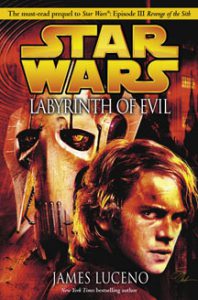James Luceno’s “Labyrinth of Evil” (2005) is one of the EU books that was most ravaged by the continuity changes that came from the “Clone Wars” TV series that started in 2008. Still, it remains an excellent read. Set immediately before Episode III, it was designed to build anticipation for May 2005’s “Revenge of the Sith,” and it does that with the Jedis’ puzzling out of Darth Sidious’ identity and Luceno’s compelling prose about various prequel-era issues.
First draft of history
Read today – when we have full knowledge of “The Clone Wars” – “Labyrinth of Evil” also stands as a time capsule of how George Lucas tweaked the narrative over time.
While some pundits like to say that the EU was one thing and Lucas’ vision was another thing entirely, Luceno’s acknowledgments in this book reveal that Lucas himself changed his mind: “Thanks … to George Lucas, for responding to my many queries,” Luceno writes. Common sense suggests that these queries were about major narrative elements in the prequel era, not minor details.

“Labyrinth of Evil” (2005)
Author: James Luceno
Series: “Star Wars: The Clone Wars,” “The Dark Lord Trilogy” No. 1
Setting: Immediately before “Revenge of the Sith”
It’s true that some things can’t be reconciled. For instance, both “Labyrinth” and the third season of the “Clone Wars” microseries chronicle the sequence of events leading to Grievous’ kidnapping of Palpatine, but there are differences in the details. This is because the TV episodes, which came out in March, were based on an early draft of “Labyrinth.”
Still, most of the book holds up – if somewhat shakily at times – in terms of EU continuity. (Disney hasn’t told its version of Palpatine’s kidnapping yet.) One of the fun things about being a Lucas-era “Star Wars” fan is playing armchair retconner, and I have retcons for most of the oddities in this book:
Unknown Maul
In “Labyrinth,” none of the Jedi know the name of the Sith that Obi-Wan killed on Naboo. So throughout their pursuit of the maker of Darth Maul’s spacecraft (part of the trail of information leading to Sidious), they never call him Darth Maul. In “The Clone Wars,” they not only know Maul’s name, but they fight him several times, as he is still alive.
Verdict: “Labyrinth’s” story still works, it’s just odd that they don’t use Maul’s name.
Unnamed Ahsoka
In “Labyrinth,” Ahsoka is never mentioned. The fact that she’s not in the story makes sense, as she had left the Jedi Order by this time, but considering the amount of inner monologues in the book, one might think Anakin would pontificate on Ahsoka.
Verdict: “The Clone Wars” itself addressed this issue. In Season 6 (“The Lost Missions”), Anakin doesn’t mention Ahsoka at all. He finally does in the “Crystal Crisis on Utapau” story reels. Anakin burying his thoughts about his ersatz Padawan is in character.

Sifo-Dyas mystery
In “Labyrinth,” Yoda and Obi-Wan share their theories on the Sifo-Dyas mystery (pages 64-69 of the paperback). But in “The Clone Wars” Season 6, they get all their answers.
Verdict: “Labyrinth” theoretically could have room for that Sifo-Dyas TV arc to take place after Yoda and Obi-Wan’s discussion but before the book’s end. (Indeed, there is a precedent: The “Clone Wars” microseries includes an Anakin mission that isn’t included in this book but has to take place during this time frame.)
Grievous error?
In “Labyrinth,” General Grievous seems to be freshly on the radar of Obi-Wan and Anakin in these latter stages of the war. In “The Clone Wars,” however, they cross his path several times. Respecting his dialog from “Revenge of the Sith,” Lucas made sure that Anakin would never meet Grievous face to face in the TV series (“Anakin Skywalker – I was expecting someone with your reputation to be a little older.” “General Grievous … You’re shorter than I expected.”)
I suspect Lucas originally intended Episode III to mark Obi-Wan’s first meeting with Grievous as well, but since the dialog doesn’t strictly preclude previous meetings, they do indeed meet in “The Clone Wars.”
Verdict: Although it’s obvious that Lucas changed his mind about the point at which Grievous would make his entrance into the narrative, there are no overt contradictions.
Encyclopedic prose
This book is a tasty enough read I don’t bemoan the lack of references to the TV series. Luceno is one of the best “Star Wars” writers at giving life to encyclopedic prose.
A highlight is Grievous’ backstory, which is featured here (on pages 92-93, 118-122 and 139-141), rather than in the “General Grievous” comic series or in the “Visionaries” entry about the cyborg general (although the “Visionaries” tale does add the wrinkle that Dooku gave Grievous a transfusion of blood from the late Sifo-Dyas).
After Grievous’ own recollections about how Separatist scientists saved his organic brain and other key organs and resurrected him as a cyborg, disturbing details come from Dooku on page 140, making Grievous as much a victim as a villain:
“(San) Hill himself had come up with the idea of the shuttle crash. … Most of the life-threatening injuries (Grievous) sustained had occurred AFTER he had been pulled from the flaming shuttle wreck, and with great calculation. … The Geonosians had ways of modifying the mind without a patient ever being aware he had been tampered with.”
Enriching the prequels
Throughout “Labyrinth,” Luceno writes engaging prose about key prequel topics such as certain senators’ opposition to Palpatine, the Jedis’ theories about who the Sith lord might be, Dooku’s defection and relationship with Sifo-Dyas and the cloners, the makeup of the Separatist council, and Anakin’s feelings for Padme.
While some people criticized Lucas’ story of Palpatine’s rise for hewing to closely to the concurrent presidency of George W. Bush, read a decade later, the story plays as a warning about any politician’s or governments’ power grab. Indeed, when Luceno references Palpatine’s four-hour State of the Republic address on page 183, that’s a Castro reference, if anything.
For the most part, Luceno enriches the prequel storyline, like when Anakin expresses his personal hatred for Nute Gunray for what he did to Padme’s planet, Naboo, in Episode I. Sometimes the author risks getting too cheeky, like when C-3PO meets TC-16 – who is even more furtive than Threepio — but I’ll forgive it.
The author smoothly references just about every major battle from the Clone Wars novels, “Republic” comics and “Clone Wars” microseries, and he also introduces or clarifies elements that will come into play in Episode III — notably the Jedi beacon, which operates separately from the HoloNet.
The bowels of Coruscant
While Luceno is generally not great at writing action or fight scenes, he does a fine job of writing about Grievous’ dispatching of various Jedis during the kidnapping sequence. Memorably, one Jedi is distracted when he accidentally kicks the decapitated head of a colleague whom the cyborg had felled.
I also enjoyed Mace Windu, Shaak Ti and their team exploring the ruins of The Works and the tunnels leading to 500 Republica, home to many wealthy politicians, including Palpatine. An outstanding sequence comes when a Republic investigator named Dyne actually does discover Sidious’ lair under 500 Republica (p. 291). Naturally, Sidious kills him:
His liquefying brain notwithstanding, Dyne found a moment to be astonished, because he recognized the man instantly. … As the Jedi suspected, the Sith had managed to infiltrate the highest levels of the Republic government.
While the absence (and minor contradictions) of some “Clone Wars” TV series elements might be initially jarring to some readers, “Labyrinth of Evil” is too on-point about the wider “Star Wars” narrative and the characterizations of the major players to be dismissed. It remains a great way to enhance your “Revenge of the Sith” experience.

